Nottinghamshire and Derbyshire Tramways
History
The first section of this standard-gauge, overhead electric tramway, which was owned and operated by the Nottinghamshire and Derbyshire Tramways Company, is believed to have been opened on the 29th July 1913. Whilst a date of the 4th July is often quoted, the available evidence from local newspapers better supports a date of the 29th July for a regular timetabled service.
The N&DTCo, which was formed on the 29th November 1902, and officialy incorporated by the parliamentary enabling act of 1903, grew out of a failed scheme to construct around 95 miles of tramway spanning the Derbyshire Nottinghamshire border, the vast majority of which would have been inter-urban in nature, covering towns such as Long Eaton, Borrowash, Allestree, Belper, Hucknall, Ilkeston, Ripley, Heanor, Langley Mill and Nottingham. The large number of local authorities through whose areas the tramway was planned to run inevitably meant that the promoters ran into significant objections, both from the local authorities themselves (some with tramway systems of their own, or plans to build them, and others who wished to extract as many concessions as possible from the company) as well as from other vested interests, chief amongst which was the Midland Railway Company. These objections resulted in a reduction in the size of the projected system to around 39 miles — powers for which were granted on the 11th August 1903 under the Nottinghamshire and Derbyshire Tramways Act 1903— though only around 11 miles were ever built.
The much-reduced scheme was still estimated to cost £450,000, a very considerable sum for the time, and perhaps unsurprisingly, the company ran into difficulties raising the capital, having to seek extensions to the time allowed for construction to commence. The extensions were authorised under the Nottinghamshire and Derbyshire Tramways Acts of 1906, 1908 and 1911, which were authorised on the 4th August 1906, the 1st August 1908, and the 18th August 1911, respectively. During this interregnum, a deal was reached to transfer the powers the company held for lines within Nottingham to Nottingham Corporation, who would then build the line between the Nottingham boundary at Cinderhill and the municipal tramway system at Basford (the company paying a rent), provided that the company actually got around to building the tramway to Cinderhill.
The funding problems were finally addressed around 1911 with the appearance of Balfour-Beatty and Company; the latter purchased the entire share capital of the N&DTCo, subsequently transferring it to a newly set-up subsidiary — the Tramways Light and Power Company — in 1912.
BB&Co had been founded in 1909 to promote, purchase, or otherwise acquire interests in provincial tramways and electric supply companies across the United Kingdom, a policy which would eventually see the company control the following systems: 1909 (Dartford Council Light Railways; Dunfermline and District Tramways; Llandudno and Colwyn Bay Electric Railway; Llanelly Tramways; Luton Corporation Tramways); 1911 (City of Carlisle Electric Tramways); 1912 (Leamington and Warwick Electric Tramways; Mansfield and District Light Railway; Nottinghamshire and Derbyshire Tramways); 1914 (Cheltenham and District Light Railway); 1920 (Falkirk and District Tramways); and lastly, in 1922 (Wemyss and District Tramways).
Around the same time as the Tramways Light and Power Company took over ownership of the N&DTCo, it also acquired the Derbyshire and Nottinghamshire Electric Power Company (suppliers to Ilkeston Corporation and its tramway), neatly solving the question of electricity supply for the planned N&DT.
The injection of capital finally led to construction work commencing, track laying beginning at several points in February 1913, with the first tram service running — between Crosshill near Codnor and Cinderhill — only 5 months later. The final section of the N&DTCo's tramway opened on the 15th January 1914, and though plans existed to extend the system, it was destined to remain as built.
The N&DTCo main line ran southeastwards from Ripley in Derbyshire to Nottingham city centre, passing through Codnor, Loscoe, Heanor, Langley Mill, Eastwood, Kimberley, Nuttall, Cinderhill and Basford, many of them mining communities. Of the 12.72 miles of tramway operated by the N&DTCo, 11.36 miles were owned by the company (from Ripley to the Nottingham City boundary) and 3.66 miles by Nottingham Corporation, the first 1.36 miles (from Cinderhill to Basford) was operated under a lease agreement, and the last 2.3 miles (from Basford to Upper Parliament Street in Nottingham) under a through-running agreement over Nottingham Corporation Tramways tracks. Although N&DTCo tramcars ran through to central Nottingham, Nottingham Corporation Tramways vehicles never provided passenger services over N&DTCo metals.
The tramway was certainly well-patronised — particularly by miners — but the good days were not to last for long, the tramway and its employees being quickly engulfed by the Great War. Although the tramway probably fared better than most, being less than a year old, the company still had to contend with severe shortages of staff (and skills), which resulted in reduced maintenance, which inevitably impacted the track and tramcars. The tramway emerged from the conflict in run-down condition, the company then making an effort to catch-up on maintenance and to improve the tramcar fleet through the fitting of a small number of top covers. The 1920s were, however, to bring new challenges, including inflation, a significant downturn in the mining industry, and perhaps most damaging of all, competition from independent motorbus operators.
In the middle of the war, the NDTCo had also seen fit to take over Ilkeston Corporation Tramways (operation on the 30th June and formal ownership on the 15th November 1916), though it was to be another 7 years before payment was finally completed. The take-over was confirmed by the Nottinghamshire and Derbyshire Tramways Act 1917, which was passed into law on the 10th July 1917. In acquiring the Ilkeston system, the N&DTCo no doubt saw a chance to expand its influence and to join the two systems up, even though they were built to different gauges. This led, in 1922, to the acquisition of powers to not only link the two tramways — between Heanor and Cotmanhay — but also, to convert the Ilkeston system to standard gauge. These powers were granted on the 29th June 1922 by the Nottinghamshire and Derbyshire Tramways Act 1922.
From a vantage point in the 21st Century, it seems quite perverse for the company to have pursued such an expensive proposal, which effectively involved the complete rebuilding and re-equipping of the Ilkeston system, given that it had been a loss-making concern, virtually from its inception. It may, however, make a little more sense when viewed in terms of the BB&Co's wider aspirations, including electricity generation and supply, the Tramways Light and Power Company, as mentioned having taken over the Derbyshire and Nottinghamshire Electric Power Company, the suppliers to Ilkeston.
By 1922, events were overtaking any plans the N&DTCo had had for expansion, its parent company (BB&Co) actively responding to motorbus competition by introducing motorbus services of its own — via a new motorbus-operating subsidiary, initially called the 'General', but soon renamed the 'Midland General Omnibus Company' — the new company sharing a depot with the N&DTCo at Langley Mill.
The Tramways Light and Power Company had meanwhile been renamed (in November 1921), becoming the Midland Counties Electric Supply Company; although it continued to own the N&DTCo, as well as the MGOCo and the Mansfield and District Tramways Company (another local BB&Co undertaking), all were operated as part of a single coordinating entity called the 'Midland General Group'.
With motorbus competition providing quicker and more modern services, and the tramway reported to be losing £30 a week by 1925, it was clear that a decision had to be made, either to modernise the undertaking or replace it with a different form of traction. The way forward was finally set in September 1928 when the N&DTCo secured powers to convert its main line, as well as the Ilkeston system, to trolleybus operation, a much-favoured form of traction at this time, especially where the tramway owner also owned the electricity generation infrastructure, as was the case with the N&DTCo. The powers were granted on the 3rd August 1928 by the Nottinghamshire and Derbyshire Traction Act 1928. As part of the act, the N&DTCo's title was formally changed to the Nottinghamshire and Derbyshire Traction Company, to reflect the impending transition.
By 1930, the track — which had inevitably suffered from mining subsidence — as well as the tramcars, were all reaching the end of their working lives, so it was imperative that the switch to trolleybus traction be quickly made. The Ilkeston system was by this time in a parlous state, so was the first to go, track lifting commencing on the 22nd December 1930, with the last tram running just over two weeks later on the 8th January 1931. The trolleybuses were, however, not yet available, so the services were operated by motorbuses for exactly one year before they in turn were displaced by the new trolleybuses on 7th January 1932.
The N&DTCo main line was next to receive attention, the first trolleybuses entering into service in August 1932, and the last tramway service proper running some time in September, the precise date, like the inauguration of services in 1913, having eluded posterity. The date that the last tram of all ran — testing the final section of new overhead trolleybus wiring — is, however, known, the 5th October 1932, through trolleybus operation beginning the following day.
Uniforms
Although several photographs have survived showing tramcar crews wearing informal attire, it is highly likely, given that the system was opened in sections, with many proving runs undertaken, that such photographs record these training/proving runs rather than revenue-earning services.
Uniforms took the form of double-breasted, lancer-style tunics with five pairs of buttons (narrowing from top to bottom) and stand-up collars; the latter appear initially not to have carried any insignia, but later on certainly carried system initials ('N & D T and 'N D T' were both used) on the bearer's left-hand collar, with an employee number (prefixed with either a 'C' or an 'M') on the bearer's right-hand collar. In later years, the system initials were worn on both collars. The uniforms were of blue serge and the buttons were plain with a scalloped rim; there is anecdotal evidence that the buttons and insignia were nickel, though this is based on peoples' memories of the last years of operation, so is potentially unreliable.
The tensioned-crown peaked caps carried standard, off-the-shelf, script-lettering grade badges — either 'Motorman' or 'Conductor' — presumably in nickel to match the buttons. One photograph has survived which shows a motorman wearing an underlined script-lettering grade badge, suggesting that they may at some point have superseded the non-underlined badges. In the last few years of operation, motormen often wore 'Driver' cap badges, probably reflecting a general decision across the company, given its impending move into trolleybus operation.
A small number of staff in the 1913 depot photograph below are wearing single-breasted jackets with lapels; these do not appear to be grade-specific, so it may simply be that the lancer-style tunics were in short supply. Later on, probably shortly after the Great War, a switch was made — for conductors only — to single-breasted jackets with five buttons, two breast pockets; stand-up collars and epaulettes; the collars carried system initials on both sides, whilst the epaulettes were left plain.
Tramcar crews were also issued with heavy-duty, double-breasted greatcoats with five pairs of buttons, high fold-over collars and epaulettes with button fastenings; the latter carried individual system initials — 'N&DT' — at the shoulder end, possibly striated to give a rope effect. Several photographs exist of motormen in oil skins, heavy aprons and leather mitts, hinting at the hardships to be endured in driving open-platform trams across country in adverse weather conditions.
Inspectors were issued with single-breasted jackets with hidden buttons (or more likely a hook and eye affair) and stand-up collars; the jackets were edged in a finer material than the main jacket, and the collars almost certainly bore 'Inspector' in embroidered script-lettering. Headgear was identical to that issued to tramcar staff, but with the grade — 'Inspector' — in embroidered script-lettering on a hat band.
In common with the vast majority of UK tramway systems, the N&DTCo employed women in significant numbers during the Great War to replace male staff lost to the armed services. These ladies were employed as conductresses, and were issued with tailored, single-breasted jackets with lapels and epaulettes, along with long, matching skirts. The majority of photos, however, show these ladies wearing heavy-duty, double-breasted greatcoats, which appear to have been identical in style to those issued to male employees; the epaulettes on the greatcoats sometimes bore system initials – 'N & D T' – worn at right angles to the epaulettes. Various types of headwear were worn: felt bonnets (possibly informal), wide-crown peaked caps, and baggy peaked caps (also called motor caps). Sometimes the caps bore metal system initials ('N & D T), sometimes standard grade badges — 'Conductor' — and at other times regimental sweetheart badges, which were frequently worn instead of the tramway badges (also the case for male staff at this time).
Further reading
For a photographic history of the tramway, see 'Nottinghamshire and Derbyshire Tramway, including the Matlock Cable Tramway' by Barry M Marsden; Middleton Press (2005).
Images
Motormen and conductors
A brand-new Tramcar No 5 on what was undoubtedly a training run prior to the tramway opening. The car is pictured in Church Street in Heanor, with the partially demolished Crown Inn in the background. Photograph courtesy of the National Tramway Museum.
An enlargement of the above photograph showing the two men on the tramcar platform. The man at the back left is Motorman Edward Stevens, who was undoubtedly instructing the man at the controls. The trainee motorman is wearing a very new-looking lancer-style tunic, along with a tensioned-crown peaked cap bear a script-lettering grade badge.
Tramcar No 13 pictured near Loscoe Grange in Loscoe on what is almost certainly another training run, again involving Motorman Edward Stevens, but this time the trainee (the man in informal attire) is a conductor. Both the motorman and the conductor are wearing smart lancer-style tunics (devoid of insignia) and tensioned-crown peaked caps bearing script-lettering grade badges.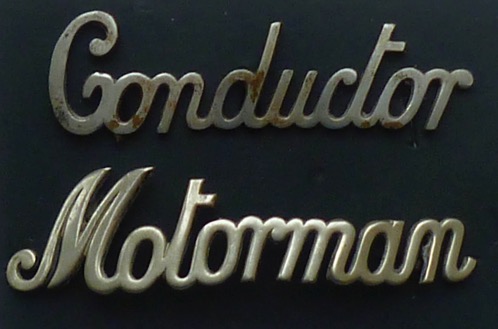
Script-lettering cap badges of the type worn by Nottinghamshire and Derbyshire Tramways Company staff — nickel. It is currently unknown whether the N&DTCo issued these grade badges in brass or nickel, though there is some anecdotal evidence to suggest that it was the latter. Author's Collection.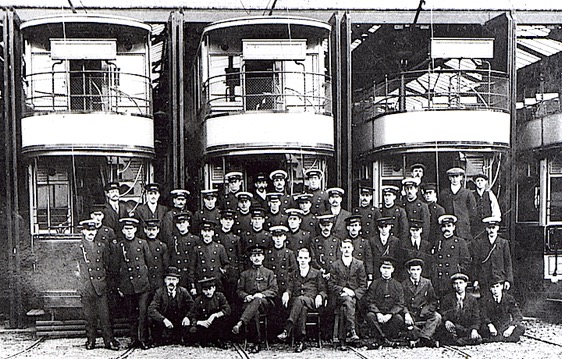
A staff photograph taken in front of the depot at Langley Mill — undated, but almost certainly taken around the time of opening, i.e., summer 1913. With thanks to Heanor and District Local History Society (see link).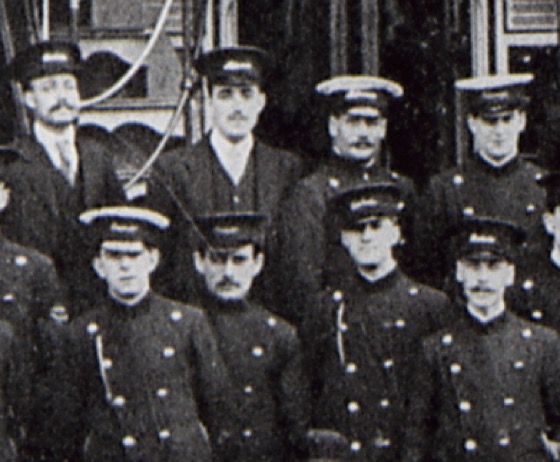
An enlargement of the above photograph showing a group of motormen and conductors. Whilst the majority are wearing lancer-style tunics, a small number have single-breasted jackets with lapels.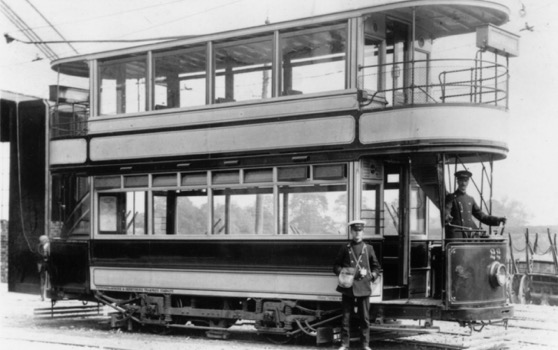
A conductor and a motorman pose with brand-new, top-covered Tramcar No 22 at Langley Mill depot in 1913. Photo courtesy of the Tramways and Light Railway Society, with thanks to David Voice.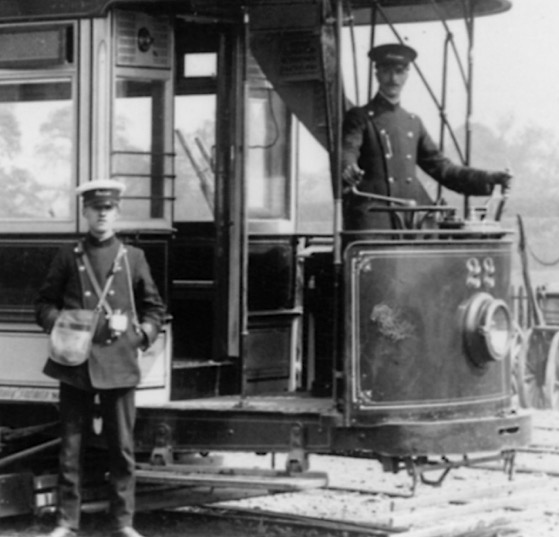
An enlargement of the above photograph showing the conductor and the motorman, both of whom are wearing lancer-style tunics with plain collars, i.e., devoid of insignia.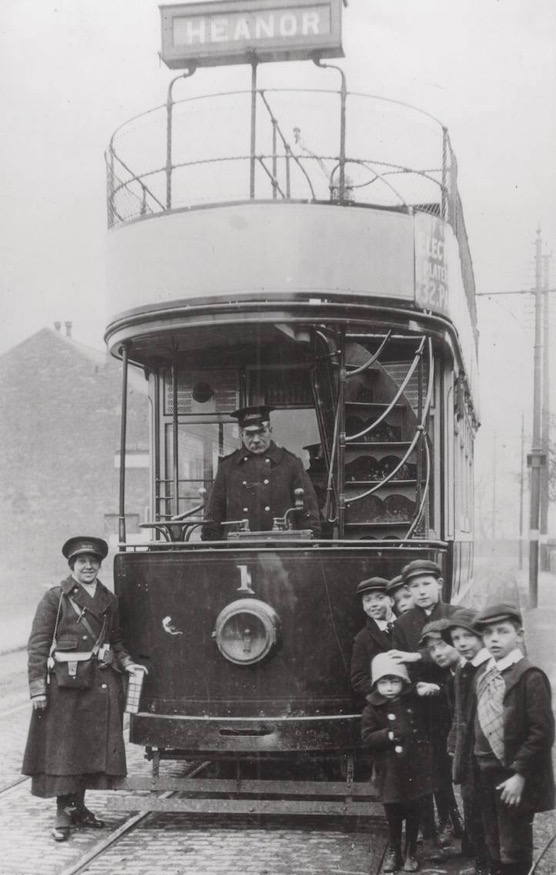
Tramcar No 1 waits at Ripley with a short working to Heanor — photo undated, but almost certainly taken during the Great War. Photo and background information courtesy of the Barry Marsden Collection.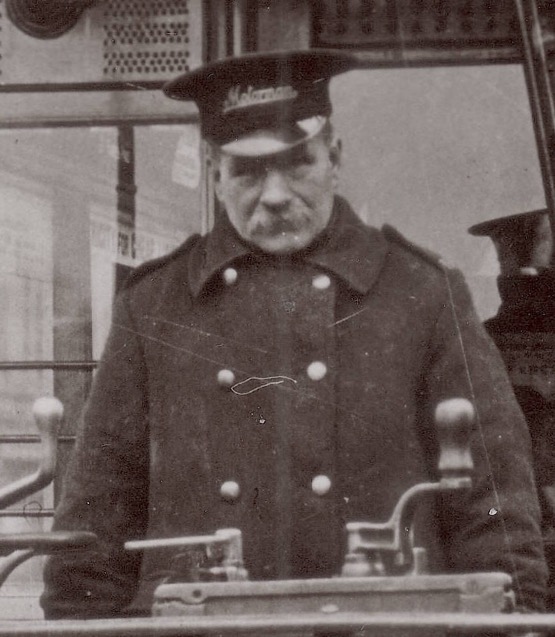
An enlargement of the above photograph showing the motorman, who is, somewhat unusually for a UK tramway system, wearing an underlined script-lettering grade badge rather than the almost ubiquitous non-underlined variety. The only badges on his heavy-duty greatcoat are on the epaulettes, which from other photos are 'N & D T' system initials.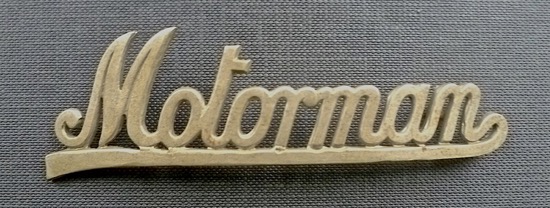
Underlined script-lettering grade badge — 'Motorman' — nickel. Author's Collection.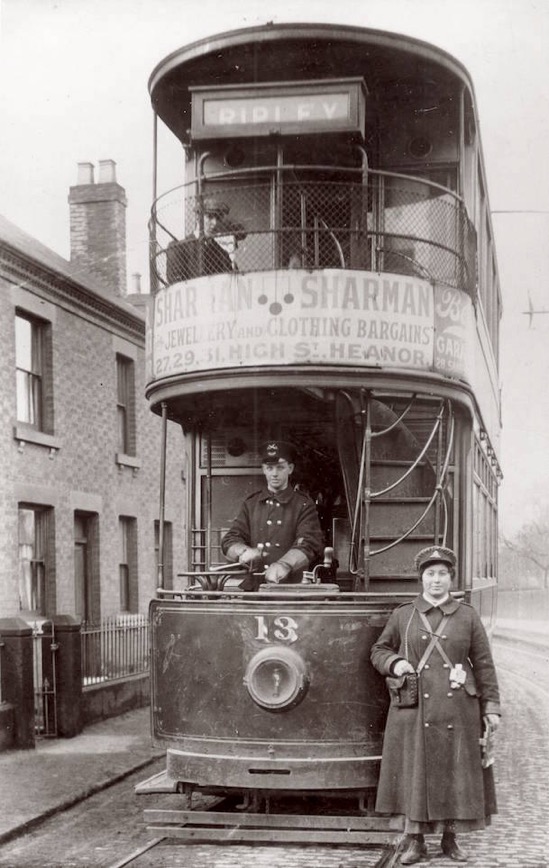
A rather tatty-looking Tramcar No 13 pictured in Station Road, Langley Mill — photo undated, but almost certainly taken during the Great War. Photo and background information courtesy of the Barry Marsden Collection.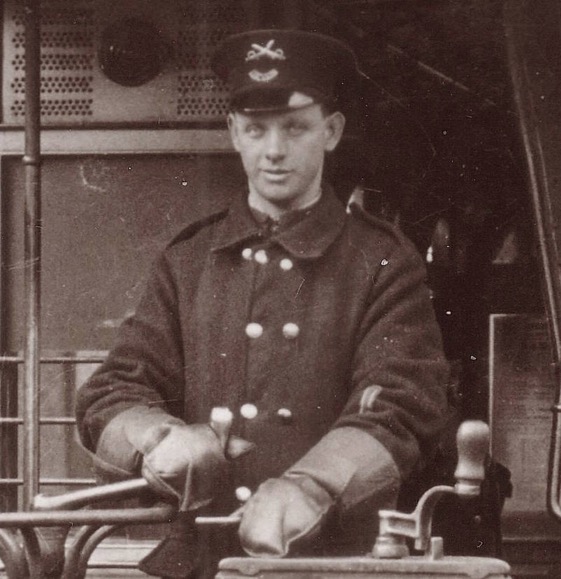
An enlargement of the above photograph showing the fresh-faced motorman, who appears to be wearing the cross-swords badge of an army Physical Training Instructor, along with a small curved badge underneath, possibly a 'FORESTERS' shoulder badge, one of the local regiments. His robust leather mitts were a necessity given the N&DTCo's 13-miles of largely cross-country running.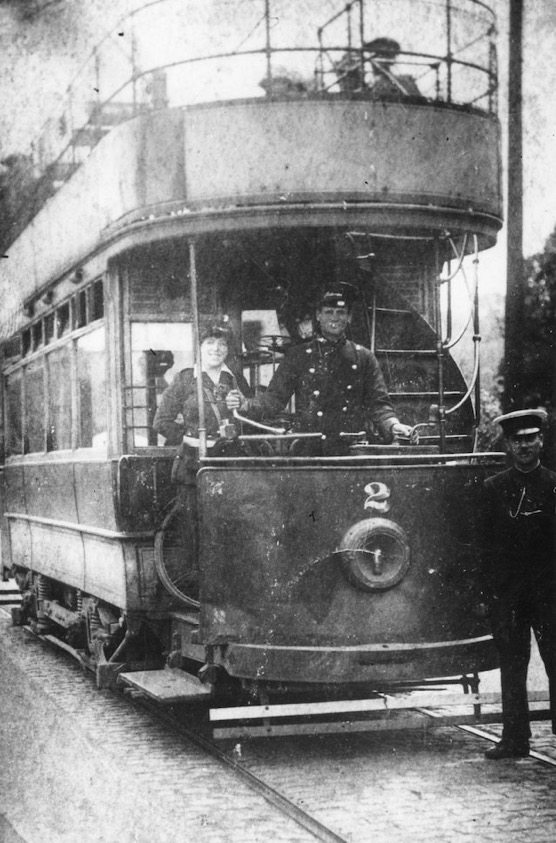
A conductress, a motorman and an inspector with a very neglected looking Tramcar No 2 — photo undated, but almost certainly taken during the Great War or shortly afterwards. The 'N D T' collar initials can just about be made out.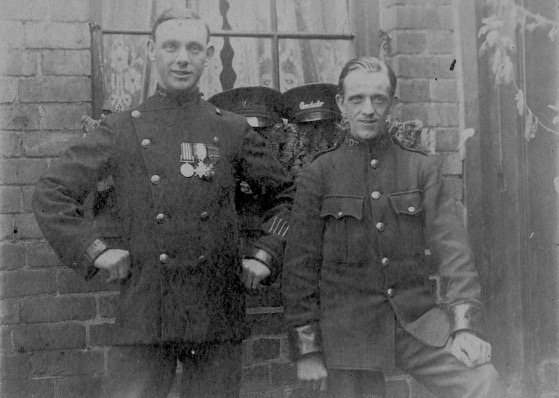
An N&DTCo motorman and a conductor pose informally at one of their homes (presumably). Although the photo is undated, the fact that the motorman (on the left) has a raft of Great War medals strongly suggests that it was taken soon after the Great War. Author's Collection.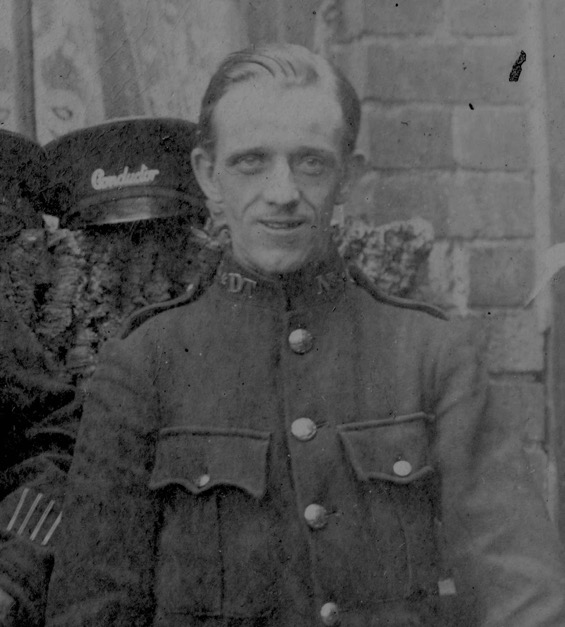
An enlargement of the above photograph showing the conductor, who has individual 'N & D T' initials on both his collars, in contrast to his colleague who only has 'N D T' initials. The photo is sharp enough to clearly show that the jacket buttons were plain with a scalloped rim.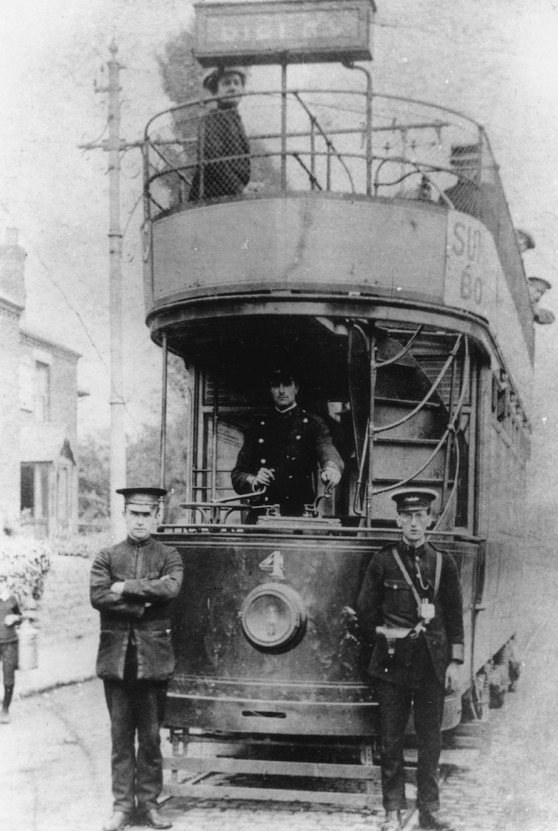
An inspector, a motorman and a conductor with Tramcar No 4, possibly at Langley Mill. The photo is undated, but was possibly taken shortly after the Great War.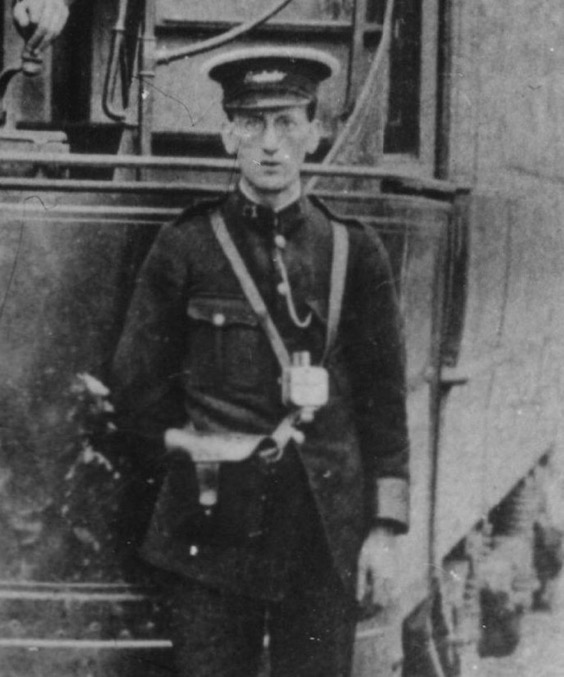
An enlargement of the above photograph showing the conductor. He is wearing a single-breasted jacket, the right-hand collar of which appears to bear an employee number ('1') prefixed with a 'C', presumably standing for 'Conductor'.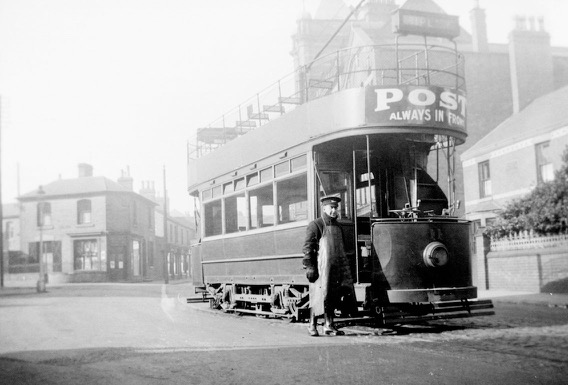
The motorman of Tramcar No 11 stands with his charge at the Ripley terminus in the last year of operation, 1932. Photo by M J O'Connor, courtesy of the National Tramway Museum. 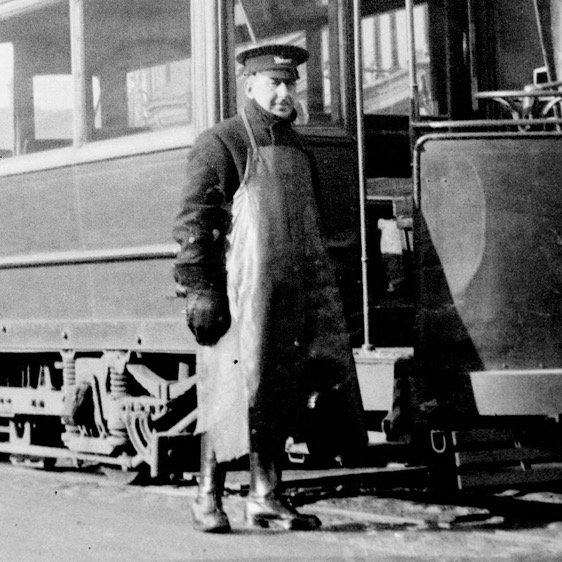
An enlargement of the above photograph showing the motorman in his full-length leather apron, mitts and upturned greatcoat collars, clearly indicating that working the N&DT with open-platform vehicles in adverse weather conditions was not to be taken lightly. His cap bears a 'Driver' grade badge rather than the 'Motorman' type used earlier. Photo by M J O'Connor, courtesy of the National Tramway Museum. 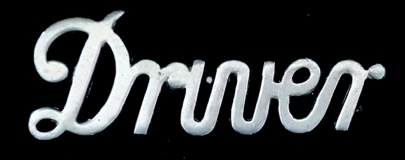
Script-lettering 'Driver' cap badge — nickel. These badges appear to have replaced their 'Motorman' counterparts late in the system's life, possibly reflecting the parent company's increasing expansion into bus operation. Author's Collection.
Senior staff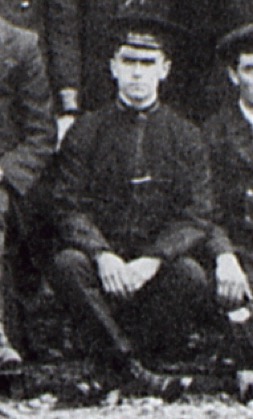
An enlargement of the depot photograph above showing one of the inspectors.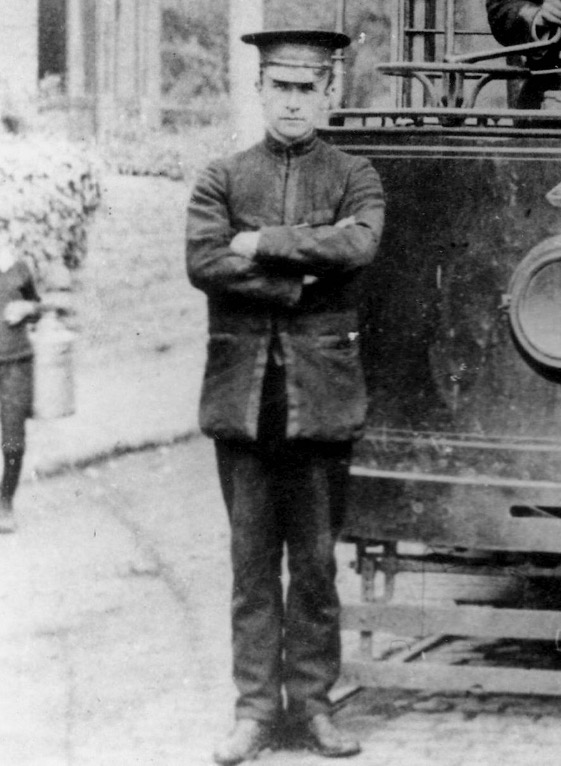
An enlargement of the Great War era photograph of Tramcar No 4 above, showing the inspector.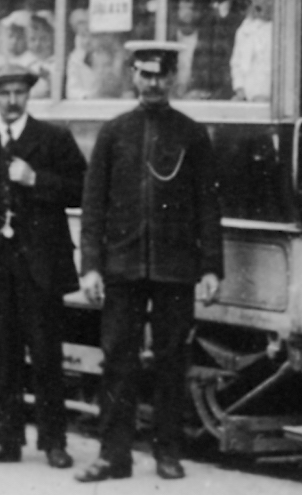
An inspector standing in front of Tramcar No 22 — photo undated, but possibly taken shortly after the Great War.
Female staff
Great War N&DTCo conductress Annie Bronson. The script-lettering cap badge and 'N&DT' system initials on the epaulette are easily made out, and appear to be striated, giving a rope-like effect. The button is possibly plain with a rim. Photo and background information courtesy of the Barry Marsden Collection.
An enlargement of the photograph above of Tramcar No 13 showing the conductress. The greatcoat appears to be devoid of insignia, whilst the cap badge is once again military, possibly Royal Artillery.
An enlargement of the photograph above of Tramcar No 1 showing the conductress. She is wearing metal 'N & D T' system initials on her cap, presumably the same as those usually worn on the epaulettes.
Tramcar No 4, looking rather battered, which if the date is correct (1916), was a mere three years old; it is pictured at Bonesetters Loop at Crosshill in Codnor in 1916, with Motorman Martin at the controls, and a conductress by the name of Emla (it is unclear whether this was her first name or family name, both being possible). Photograph courtesy of the National Tramway Museum.
An enlargement of the above photograph showing Conductress Emla, who was a Belgian refugee. She is wearing the usual Notts & Derbys baggy greatcoat together with a bonnet, no insignia being in evidence.